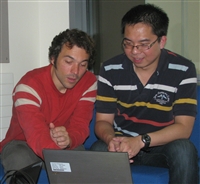
Creating and sharing digital content on your course

Creating course content
Not all of the online content you use in relation to your course will be provided by your lecturers. As a student, you may be asked to develop digital content as part of a formal course task or you may be sharing digital content you have made informally with other students. The type of digital content involved will mainly depend on your subject area. However, selecting the right tools for the job is also important, especially given the wide range to choose from.
In these activities you will practise identifying appropriate tools to use for creating or sharing digital content, and try out some of them to evaluate their usefulness.
Activity 1: The right tools for creating and sharing
Not all software is flexible enough to use for creating digital content for study-related tasks. Web-based social networking applications can sometimes be more suited to meeting student needs in this respect. However, care is still needed when choosing which tool to use for creating and sharing digital content and this should be done in the early stages of planning.

Instruction
Look at these typical study-related tasks which involve some digital content creation or sharing. Consider the possible tools that might be used for each of them. Select the tick symbol next to any tools in the list which would be suitable for performing the task and select the cross symbol next to any tools which would be less useful. Then read the feedback.
Task 1: Your lecturer has asked you to plan, create and execute a group presentation in class on a research-based topic. This will be assessed as part of the module you are studying. You have 2 weeks to plan and prepare the content for the class presentation.
PowerPoint
Prezi
Email
SlideShare
Dropbox
Task 2: For one of your modules the tutor has asked everyone to conduct a market survey and use a suitable online tool to share findings with the rest of the group. How could you do this?
a spreadsheet in Google Docs
an open wiki
your personal blog
a restricted blog
your website
Task 3: For your course you have been asked to create a video presentation in small groups of the historical points of interest in the town where you are studying. You need to select appropriate tools for both filming and editing.
a digiCam
Windows Movie Maker
a gaming device
a WebCam
a mobile phone
Activity 2: Trying out a digital tool to assess its suitability
The best way to learn about the suitability of any web tool for a task is to try it out. In this activity you are going to choose a tool to use for a particular task and evaluate how useful it is.

Instruction
Choose one of the tasks and the suggested tool. Try to do the task by yourself or with another student and evaluate the usefulness of the tool for this purpose. Make some notes on the benefits and limitations of the tool. Then read the feedback. Open the help section first if you would like some guidance in preparing to use one of the tools.
Task 1:
In some subject areas, students might be asked to produce a poster presentation showing the results of an individual or group project. There are a number of tools that could be used to create a poster but if you have not created one before you might find it easiest to create it using a slide. Open the poster slide template below in PowerPoint and try to use it to create a simple poster for a project or topic related to your course.
Poster template (ppt, 141KB).
Task 2:
You might be required to do some collaborative writing at some point during your course. Use notes from a lecture that you and another student have recently attended to produce a joint summary. Open the link to Google docs and try using the application for this purpose with another student online (but in a different location to you).
Google Docs
Task 3:
Curation tools can serve a useful purpose for students especially for gathering relevant references and links in one place online. Use the link below to the Livebinders application to create a private 'folder' of useful references and other notes for a topic you are studying. When you have completed it, share the link with another student.
LiveBinders
© eLanguages, Modern Languages and Linguistics, University of Southampton, 2018. All rights reserved.
 PowerPoint
PowerPoint